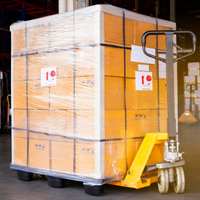Unlocking the Power of JD Edwards Barcode Software: A Comprehensive Guide to Boosting Accuracy, Efficiency, and Cost Savings Across Industries
- Data Collection
- ERP Systems
- Oracle JD Edwards
OVERVIEW:
- A Brief History of Barcode Software for JD Edwards
- Advantages of JD Edwards Barcode Software
- Barcoding 101 for JD Edwards
- Industry-Specific Applications
- JD Edwards Barcoding Best Practices
- Integration with Other Software
- Real-World Case Studies
- Future of JD Edwards Barcoding
A warehouse barcode system can change the way businesses manage their inventory, streamline their supply chains, and improve operational efficiencies. In today’s fast-paced business environment, the need for accurate, reliable, and efficient inventory management has never been more critical.
JD Edwards barcode software drives operational performance through mobile automation. Leveraging barcoding technology and mobile inventory software drives operational excellence while maximizing the bottom line.
With JD Edwards barcode software, organizations can automate supply chain processes, including inventory management, order processing, and shipping. Data captured from scanning barcodes and other automated data collection methods updates JD Edwards in real time. This greatly simplifies accuracy and visibility across the supply chain.
In this comprehensive guide, we will explore JD Edwards barcode software, its history, advantages, best practices, industry-specific applications, and real-life case studies.
A Brief History of Barcode Software for JD Edwards
The first barcode was invented in 1948 by Normal Woodland and Bernard Silver. However, it wasn’t until the 1970s that barcode technology became widely used in retail, thanks to the introduction of the Universal Product Code (UPC).
That takes us to 1977, when enterprise resource planning (ERP) software company JD Edwards was founded by Jack Thompson, Dan Gregory, and Ed McVaney. The company was named after McVaney’s middle name, Josephat, and his wife’s maiden name, Edwards.
In its early days, the software company focused on developing accounting software for IBM’s mid-range computers, which were popular in the manufacturing industry. In the 1980s, the company expanded its product offerings to include manufacturing and distribution software. This helped JD Edwards become one of the leading ERP software providers in the market.
During the 1990s, JD Edwards continued to expand its product offerings with the release of its flagship product, JD Edwards World. It was during this time that barcode software began to be integrated into ERP platforms like JD Edwards.
In 1997, the company went public and was later acquired by PeopleSoft in 2003. Oracle acquired the platform in 2005, making JD Edwards a part of Oracle’s suite of enterprise software solutions. Later, JD Edwards released its latest product, JD Edwards EnterpriseOne, which can be deployed both on-premises or in the cloud.
Today, JD Edwards is still widely used in manufacturing and distribution, along with an essential tool: barcode software.

Advantages of JD Edwards Barcode Software
JD Edwards barcode software offers numerous benefits to businesses in all industries. Barcode scanning automates data collection to ensure perfect capture instantly, eliminating the need for paper or manual processes. Mobile barcoding takes automation one step further with point-and-scan mobile apps. The benefits of this automation are numerous.
Some of the top advantages of barcode software include:
- Increased Accuracy. Automating the data collection process eliminates the possibility of human errors, such as incorrect data entry or mislabeling of products.
- Improved Efficiency. Automation streamlines inventory control processes, reducing the amount of time and resources required for handling.
- Increased Productivity. Barcode scanning is much faster than manual data entry. A 30-minute task can be reduced to a couple of seconds, allowing employees to spend more time on higher-value activities.
- Improved Customer Service. Gains in accuracy and efficiency help businesses provide faster and more accurate service to customers, improving customer satisfaction and loyalty.
- Cost Savings. Accuracy and efficiency boosts translate directly to reduced waste, and lower overhead, carrying, and labor costs—not to mention fewer mistakes.

How to Bridge Gaps in JDE Functionality with Mobile Barcoding
READ NOW»Barcoding 101 for JD Edwards
Barcodes are machine-readable codes that use a series of bars and spaces of varying widths to represent data. Barcodes are typically printed on labels or tags and can be scanned using a barcode scanner. There are different types of barcodes, including UPC (Universal Product Code), EAN (European Article Number), Code 128, Code 39, and others.
1-D barcodes, also known as linear barcodes, are the most common type. They can be found on virtually any product on the market, most commonly in the form of a UPC in retail and the Code 39 used in logistics and inventory management.
2-D barcodes, also known as matrix or stacked barcodes, are more complex and hold more data. They contain a pattern of squares, dots, or hexagons that represent data or information. Examples of 2-D barcodes include the Data Matrix and PDF417 used in manufacturing and logistics, and the QR code (“Quick Response”) for smartphone cameras.
JD Edwards barcode software supports a wide range of barcode types and can be customized to meet the specific needs of different industries. Solutions like RFgen include on-demand barcode generators and printers for mobile devices to help ensure maximum productivity and labeling compliance.
A key advantage of mobile barcoding is its ability to seamlessly integrate with JD Edwards, as well as other enterprise software systems and ERP platforms. Data captured via barcode scans, RFID, or other automated data collection methods keep JD Edwards accurate at all times, even while operating offline.

Industry-Specific Applications
JD Edwards barcode software can be used in a wide range of industries, including manufacturing, distribution, food and beverage, aerospace and defense, oil and gas, and more. Other sectors, like healthcare, retail, and logistics also benefit.
The flexibility of mobile barcoding solutions allows for customization to suit any industry-specific supply chain requirements.
Here are some examples of how the software can be applied in different sectors:
Manufacturing
JD Edwards barcode software can streamline manufacturing processes by automating data collection, reducing manual errors, and enhancing inventory control. For instance, a manufacturer can use barcodes to track the movement of raw materials, monitor production progress, and manage finished goods inventory.

JD Edwards barcoding success stories
READ NOW »Retail
JD Edwards barcode software can also help retailers streamline their operations, reduce costs, and improve customer experience. For example, retailers can use barcode scanning to speed up the checkout process, improve inventory accuracy, and manage their supply chain more effectively.
Healthcare
Barcode scanning software helps JD Edwards users in the healthcare sector improve patient safety, enhance medication management, and automate data collection. For instance, hospitals can use barcode scanning to track patient care, reduce medication errors, cycle count stock levels, and manage medical supply inventory and consignment stock.
Logistics
For logistics, JD Edwards barcode software optimizes inbound and outbound warehouse operations. Order fulfillment benefits from reduced errors and fewer chargebacks or returns. Many logistics companies use barcodes to track shipments and manage inventory, improving supply chain visibility.

JD Edwards Barcoding Best Practices
To get the most out of JD Edwards barcode software, it’s essential to follow best practices. Here are some tips to help you implement and use barcoding effectively:
Barcode Design
A well-designed barcode is critical for accurate scanning and data capture. It should be easy to read and accurately represent the product or item being tracked. To ensure optimal readability, barcodes should be printed at an appropriate size and resolution, and the barcode symbology used should match the scanner being used.
Barcode Scanning Techniques
Proper scanning technique is essential for accurate data capture. Scanners should be held perpendicular to the barcode, with the scan line centered horizontally across the barcode. The scanner should be moved smoothly across the barcode at a moderate speed. Multiple scans may be necessary to capture data accurately.
Industrial-grade devices are more likely to scan correctly the first time, even from distances of up to several dozen feet away.
Barcode Hardware Maintenance
Barcode scanners and printers require regular maintenance to ensure optimal performance. This includes cleaning the scanner lens and printer head, regularly calibrating the scanner, and replacing worn or damaged parts as needed. Proper maintenance can keep industrial barcode scanners functioning for 5 years or more.
Training and Education
Proper training on new barcode software is a must. Employees should be trained on how to use scanners and interpret barcode data, as well as the importance of accurate data entry. Fortunately, mobile apps are easy to learn and simple to use and often come with built-in data validations to prevent errors.

Integration with Other Software
Integration with other enterprise business systems is a critical consideration when evaluating barcoding solutions for JD Edwards. It’s important to connect barcode data with the organization’s larger software ecosystem to ensure data is always up to date.
Reliable data is the basis for effective decision-making and crystal-clear visibility across the supply chain. Both areas factor into optimizations in procurement, production planning, distribution, and profit margins.
Barcode systems purpose-built for JD Edwards, like the solutions offered by RFgen Software, can be integrated with a wide range of other technologies. Essentially, any system that collects or communicates data can be automated and integrated into mobile software that shuttles information to and from JD Edwards in real time.
Mobile barcoding seamlessly integrates with:
- Multiple ERP platforms: Oracle’s JD Edwards, E-Business Suite, Oracle SCM Cloud, SAP, Microsoft Dynamics 365 SCM, Deltek Costpoint
- Warehouse and production systems: IMS, WMS, legacy databases, QMS, TMS, and more
- Physical automation devices: IoT/IIoT, carousels, scales, autonomous vehicles, cobots, etc.

3 Ways Mobile Barcoding Helps with Securing Remote Access
READ NOW»Advanced JD Edwards Solutions
RFgen mobile software can also be used to augment JD Edwards with unique or complex functionality, filling capability gaps and preserving legacy workflows when migrating between ERPs. Built on a robust mobile platform with prebuilt applications, even advanced solutions can be quickly tailored to meet unique processes and deployed to end-users.
Most often, JD Edwards customers are seeking some of the functionality provided by other systems or ERP modules, but either do not need a full version of that system or do not have the internal resources to implement it. In either case, RFgen adopters can gain the desired functionality with advanced solutions such as:
License Plating
The RFgen License Plating solution greatly accelerates inventory flows and traceability. A license plate is a master barcode assigned to a group of items to enable single-scan bulk movements while retaining granular data points of each individual item in the license plate number (LPN).

Everything You Need to Know About License Plating
GET THE GUIDE »Advanced Warehousing: WMS Alternative
For businesses that can’t spare the expense or heavy lift required to implement a full WMS solution, RFgen Warehouse Director provides a more flexible, cost-effective alternative that helps build a more intelligent, automated warehouse. The RFgen Warehouse Director equips facilities with directed-movement capabilities that automatically “direct” workers to the optimal locations for put-away, replenishment, picking, and cross-docking.

Gain Essential WMS Functionality at a Fraction of the Cost
READ NOW »Low-Code Mobile App Development
RFgen Mobile Development Studio empowers internal technical teams with the ability to build, configure, and maintain mobile apps in-house. Simple drag-and-drop functionality and repeatable components that automatically scale to different screen sizes help reduce development lifecycles by up to 95%.
Real-World Case Studies
Next, let’s look at several examples of how JD Edwards mobile barcoding has been successfully implemented in multiple industries and operational types.
Here are just a few examples:
Success in Manufacturing: Clif Bar & Company
Clif Bar & Company, a maker of organic and natural energy bars, implemented RFgen’s mobile data collection software to automate their inventory management and streamline production within their JD Edwards system. The new mobile software allowed Clif Bar to scan barcodes, track inventory in real time, and perform inventory counts more efficiently, resulting in significant cost savings and increased productivity.
Eliminating manual data entry errors improved accuracy, enabling real-time visibility into inventory levels. Trustworthy information could then be used to make data-driven decisions and respond quickly to changing market demands. The end results included lower overhead, efficiency gains, digital transformation, and enhanced sustainability.
Success in Food & Beverage: Caito Foods
Fresh food distributor Caito Foods implemented RFgen’s JD Edwards barcode software to achieve fast, flawless traceability, from farm to fork. In addition to achieving full compliance with government regulatory requirements, the company also enhanced operations at distribution centers with optimized pick, pack, and ship processes.
Making the leap from paper processes to digital inventory enabled Caito Foods to generate accurate, up-to-the-minute reports. Intuitive, easy-to-use mobile apps for advanced inventory control also meant 77% shorter training times for new hires and seasonal workers.
Success in Distribution: Life Extension
Finding their manual processes and paper notes untenable for inventory management, Life Extension mobilized inventory and lot control in the warehouse with RFgen mobile barcoding for JD Edwards. The new system optimized warehouse operations, increased productivity, and dramatically improved inventory accuracy.
Inventory could now be controlled from item-level to lot-level in real time. This meant full visibility into material movements and accelerated throughput. The ability to conduct bulk picking and directed picking added additional layers of efficiency, unlocking company growth.
Other Success Stories
RFgen’s mobile barcoding solutions have helped thousands of companies streamline their operations and achieve 99.9% accuracy and gains of 30% efficiency and worker productivity, or more.
Explore these case studies below:
- Myers Tire Supply, a just-in-time tire redistributor, saw a significant transformation in its fast-paced operations reducing inventory adjustments by 80%.
- National Food Products Company (NFPC), a food and beverage company in the United Arab Emirates, greatly reduced inventory handling time to generate significant cost savings.
- Capstone Nutrition, a manufacturer of nutritional supplements, improved quality control while boosting productivity by 50%.
- Chateau Ste. Michelle Winery, a premium winemaker in Washington state, enhanced lot traceability with RFgen License Plating solutions.
- Trident Seafoods, a seafood processing and distribution company, added 24/7 Continuous Availability to their solution for round-the-clock offline inventory control.
In each of these cases, RFgen’s mobile barcoding solution for JD Edwards helped the company improve performance, cut costs, and stay competitive in their respective industries.

Top Mobile Barcoding Case Studies for Oracle’s JD Edwards
READ NOW »The Future of JD Edwards Barcoding
JD Edwards barcode software is a crucial tool for businesses looking to increase efficiency, accuracy, and cost savings. Mobile devices are increasingly being used as barcode scanners to simplify workflows and reduce costs.
Looking ahead, enterprise users will continue to integrate newer technologies into their JDE stack. Mobile apps have already proved instrumental in helping to connect these diverse technologies into a single, holistic environment, from IoT/IIoT data collection to industrial computers and robotic scales.
While many JD Edwards users are worried about the future of software as time goes on, rest assured that the right mobile barcoding solution can help you extend the value and life of your technology investment.
Regardless of your needs, RFgen software is easy to use and quickly configurable to unique processes, no matter how complex. To stay competitive in today’s world, companies running on JD Edwards need real-time data and perfect accuracy to remain profitable. By staying up-to-date with the latest mobile barcoding solutions, these businesses can ensure they are well-positioned to take advantage of all the benefits that mobile barcoding has to offer, now and in the future.




